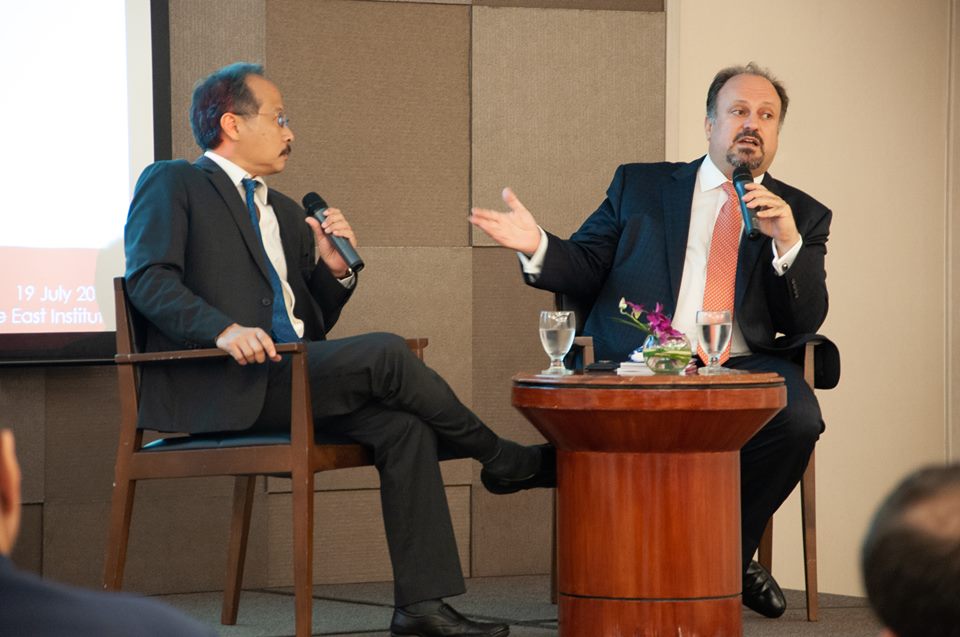Professor Haykel delivers a lecture on Crown Prince Muhammad bin Salman’s push for economic and social reform in Saudi Arabia.
Transformation of Saudi Arabia: Can MBS’ Economic and Religious Reforms Succeed?
- - July 25, 2018

On the 19th of July, Professor Bernard Haykel, a professor of Near Eastern Studies at Princeton University, gave a lecture on the crown prince of Saudi Arabia’s reformation project, as part of the MEI Prominent Speaker Series. He began by providing a historical background, illustrating how until the death of King Abdulaziz ibn Saud in 1953, the country was run by an absolute monarchy. Following his death, the sons took over different aspects of the government, with power shared among them. Because of the diffusion of power, decision making took a very long time. It was an extremely opaque system. The crown jewels of bureaucracy, Saudi Aramco and SAMA (Saudi Arabian Money Authority), were never controlled by the princes.
In 2015, King Abdullah died, after which King Salman ascended to the throne. King Salman felt that the country needed two axes for reformation. The first was economic diversification, as students were graduating and needed jobs but the government, the biggest employer in Saudi Arabia, was unable to create more jobs. Professor Haykel described how the oil and government were linked, and how after the first oil shock of 1973, the government provided Saudi citizens with subsidized healthcare and education. The second axis is responding to the threat of Iran to the kingdom. Iran, from Saudi Arabia’s point of view, was preaching death to the US, Israel, and Saudi Arabia – it viewed Saudi Arabia as a threat.
Professor Haykel also outlined the progression of the relationship between Saudi Arabia and the United States, stating that it unraveled after the Cold War and needed to be reconfigured. In 1945, Roosevelt and Abdulaziz ibn Saud struck a deal where the United States would be an ally of Saudi Arabia and provide them with military protection as long as the kingdom agreed to be the central bank of oil for the world, and to not use it as a weapon like many other postcolonial states were using it. After the 9/11 attacks, the people of the United States began questioning its alliances, especially due to the fact that Osama bin Laden was a Saudi citizen. Popular American thinking was quite anti-Saudi, which created turbulence in the two countries’ relations. The Saudis were against the United States’ invasion of Iraq in 2003, as they thought it would result in greater Iranian influence in Iraq.
The election of President Obama in 2008 heralded another three detriments to Saudi-US relations. The first was the “pivot to the east” that Obama proposed, which Saudi Arabia interpreted as an abandonment of the Middle East. Secondly, the United States abandoned the Mubarak regime in Egypt, and Obama was seen to be in support of the Muslim Brotherhood, which posed a threat to Saudi Arabia. Finally, the United States’ increasing relations with Iran was seen to legitimize the Iranian sphere of influence in the region. These factors caused Saudi Arabia to realize that they needed to build their own resources and not rely on the United States.
King Salman felt as if he had been dealt a poor hand, and delegated power to the kingdom’s crown prince. In King Salman’s view, it was important to build up military and political capacities and diversify the economy. In 2017, after Muhammad bin Nayef was removed, Muhammad bin Salman (“MBS”) ascended to the position of crown prince. In the crown prince’s view, there were two aspects essential in the transformation of Saudi Arabia. The first element was that the country must be socially transformed, with efforts to lessen the presence of the religious police, emphasize women’s rights, and provide more music concerts and cinema so that Saudis can stay and spend money at home as opposed to travelling to Abu Dhabi or Dubai. Professor Haykel argued that for this, it was essential to tame the conservative religious establishment, which holds an enormous amount of social space. The second element was economic regulation and the promotion of foreign direct investment. Professor Haykel illustrated that here it is necessary to change the culture of employment in Saudi Arabia, so that people seek more jobs in the private sector as opposed to the government.
According to Professor Haykel, many people in Saudi Arabia feel that MBS has a very large vision, and are of the opinion that he does not have to fully succeed for citizens to be satisfied. 70% of the public is less than 30 years old, and see MBS as their savior. MBS proposes economic and social reform, but there is no idea of political reform. In fact, power has been consolidated in a way that is more reminiscent of the absolute monarchy that existed in Saudi Arabia before 1953 – and, as Professor Haykel sees it, this absolute monarchy is essential in order to effectively push through reforms.
At the same time, Saudi Arabia has had several policy initiatives, including their involvement in the war in Yemen. Saudi Arabia and the UAE have supported factions in Yemen to fight the Iranian-supported Houthis. The Houthis successfully took over the capital of Yemen, Sana’a, in September, and Saudi Arabia fears that Yemen could be controlled by the Houthis much in the way that Lebanon is controlled by Hezbollah. The situation in Yemen is a major humanitarian disaster, but Professor Haykel argued that this crisis precedes Saudi involvement, as there already was a civil war. Professor Haykel described how the Saudi government is very intent on stopping the Iranians from gaining a foothold in Yemen. Involvement in Yemen also provides the Saudi military with opportunity for improvement. As Professor Haykel argued, a main goal of MBS is to turn Saudi Arabia from a client state of the United States into a fully-fledged influencer and actor in the region and globally.
During the extensive Q&A session, a question was raised regarding the export of Salafism and Wahhabism from Saudi Arabia. To what extent will MBS halt this support and export of these ideologies? Professor Haykel offered a response that highlighted the complicated story that comes along with that question. In the 1950s, the United States asked Saudi Arabia to promote a more conservative Islam in order to fight communism, and so the Saudi element in spreading Salafism and Wahhabism does not entirely explain how it has spread, and Saudi Arabia cannot take full responsibility for stopping it. The Islamic revival also has to do with the failings of liberalism, Marxism, and Arab nationalism – these things are also responsible for the turn to Salafism.
Bernard Haykel is a scholar of the Arabian Peninsula, focusing on the politics, economics and history of Saudi Arabia, the other Gulf Cooperation Countries (GCC), and Yemen. He is professor of Near Eastern Studies at Princeton University where he is also the acting chair of the department. In addition, he is director of the Institute for the Transregional Study of the Contemporary Middle East and the Program in Near Eastern Studies. He has led Princeton’s Project on Oil, Energy and the Middle East. Professor Haykel is the author of “Revival and Reform in Islam,” and most recently the co-editor of “Saudi Arabia in Transition,” both published by Cambridge University Press. He earned his doctorate from the University of Oxford.
More in This Series
More in This Series
- Jean-Loup Samaan
- - July 11, 2024
- Aisha Al-Sarihi, Ehsan Rasoulinezhad, Jinseok Sung
- - June 20, 2024








